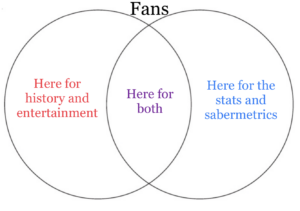
Welcome to what I hope will be an enjoyable experience for you. This is the first installment of a series I wanted to write on Baseball Almanac. My sense is that most baseball fans can be illustrated through a Venn diagram, with folks favoring the history and sheer entertainment aspect of the game on one side and hardcore statistics aficionados on the other.

Where the two overlap is my wheelhouse. I want to engage both sets of audiences. Sometimes you might feel like I’m more in sync with your views on the game than at others. I promise to be as inclusive as possible in addressing fans’ desires from both camps.
While I want to stir your emotions on the topic of sabermetrics, I’m not interested in creating some bench-clearing brawl among the patrons of Baseball Almanac. Let’s stay away from the brushback pitches, and everyone can keep their ego intact. With that, let’s begin.
Sabermetrics is about advancing our collective understanding of baseball through statistical research. It’s not subversive. It’s not new math. It is not meant to upset any balance of power except where the system has arbitrary rules and measures. If simply hearing the word sabermetrics gives you a visceral reaction, I’d ask you to think about the overwhelming variety of technological tools you use every day.
I doubt you record your household budget and taxes in a leatherbound parchment volume, complete with a quill pen and ink well, even though it was a traditionally accepted format for accounting when baseball sprang to life in the 1800s. Instead, you probably use a software program to file your taxes each year. Moreover, you probably pay close attention to a single number from the federal and state governments as the end-all indicator of the previous year’s success. Of course, I’m referring to either owing taxes or receiving a refund. That single data point, comforting or concerning, is the result of layers of underlying statistics. Your refund status is an advanced tax statistic. The tools for recording and filing taxes may have changed over the last 100 years; compulsory taxes have not.
You see, modern sabermetrics isn’t all that different from the tax software tool described above. Just like an ever-increasing set of tax laws requires greater sophistication to navigate the income-tax labyrinth each year, sophisticated baseball evaluation tools allow us to see what truly matters more clearly by lifting up data points that most accurately measure success. Having the right tool is the difference between doing the job and a job well done. Let’s look at another example.
The fact is tools are improved upon or replaced with better, newer tools that rely on more sophisticated technology. Unfortunately, one of the primary sabermetrics tools hasn’t been replaced for years. I’m referring to the runs-scored estimation algorithms. Using outdated estimation tools that were accurate for their era is like using your dad’s hand-me-down golf clubs that have been collecting dust in the shed for years.
Imagine we’re a group of five guys from work playing a par-3 executive golf course. All holes can be reached from the tees. Each of us is using a different set of clubs. You can take your pick of which clubs (algorithm) you want to use. Maybe you’re a Runs Created fan, so you’re using a set of Bill James clubs. My clubs (Predicted Outcomes Runs, pOR2) are new and different. Nobody has ever seen anything quite like them because they were crafted in a mad scientist’s laboratory—like something out of Back to the Future. You all give me heck about my clubs because you’ve never heard of them, and I tell you we will let the tools (algorithms) have the final say.
As a Bill James club guy, you reached the green on six of your tee shots. It’s respectable, and you’re feeling good about your performance. Let’s say another member of our group is using a Jim Furtado set of Extrapolated Runs clubs. He reaches the green on seven drives. Naturally, he is feeling proud.
I agreed to hit last on each hole, regardless of who won the hole. I want each of you to feel good about your performance, even though I know my clubs are superior to yours. When I step up to take my tee shots, you grow more and more frustrated because I reach the green thirteen times on my drives. It doesn’t seem possible, but I keep repeating my swing. I tell you, it’s the clubs; you’re grumbling under your breath.
When we add up the score at the end of the round, even my bad shots got me closer to the pin than almost any shot each member took. Each of you parred sixteen holes. It was a good round for everyone, but you’re still furious with me. I birdied seventeen holes, and my worst hole was a par.
In a side-by-side comparison, my clubs simply dominate the day. You see, I studied how the clubs each of you used were designed. I took what didn’t work for them as a lesson of something I wanted to avoid. I decided that I would create the best clubs possible based on the technology currently available. Moreover, I committed myself to improve the clubs’ function by focusing on accuracy and precision.
Your clubs were considered accurate when they were designed. Over time, the creators of those clubs were lauded as advancing baseball research. That’s the mission of SABR (Society for American Baseball Research). Pretending that we’ve reached an arbitrary finish line on a particular topic is foolish. We won’t ever be done researching topics in baseball if only to use new studies to validate prior research.
If our goal is to constantly advance the understanding and appreciation of baseball, why would we choose to ignore new research that challenges old ideas?
I hope you’ve enjoyed this introductory weekly column. I want to challenge your thinking about baseball statistics. Someday, my own research on the game will become outdated. Please feel free to spar with me about the ideas I’ve presented here—I enjoy the discussion because it challenges my thinking. I can be reached here on Baseball Almanac, via email at chriswrites@schristophermichaels.com, and I’m on the social media (Facebook, Twitter). As always, this has been the World According to Chris. Thanks for tuning in.

